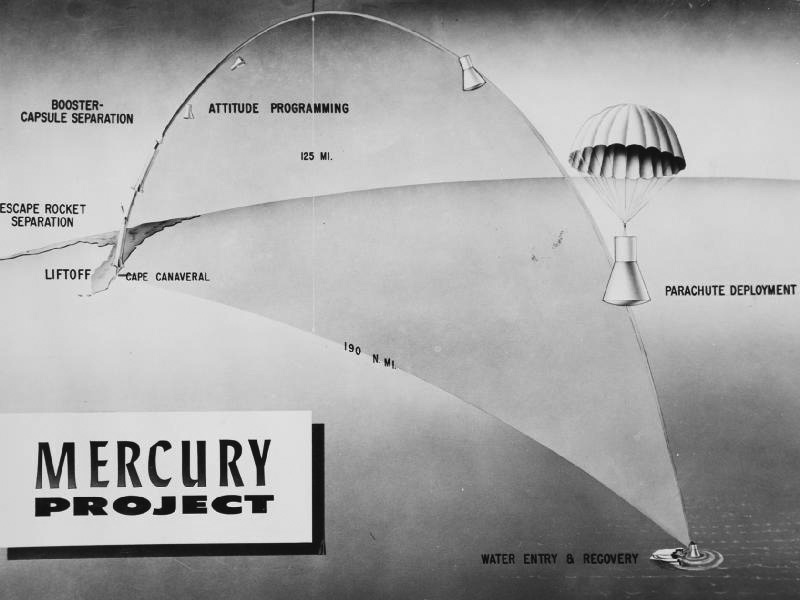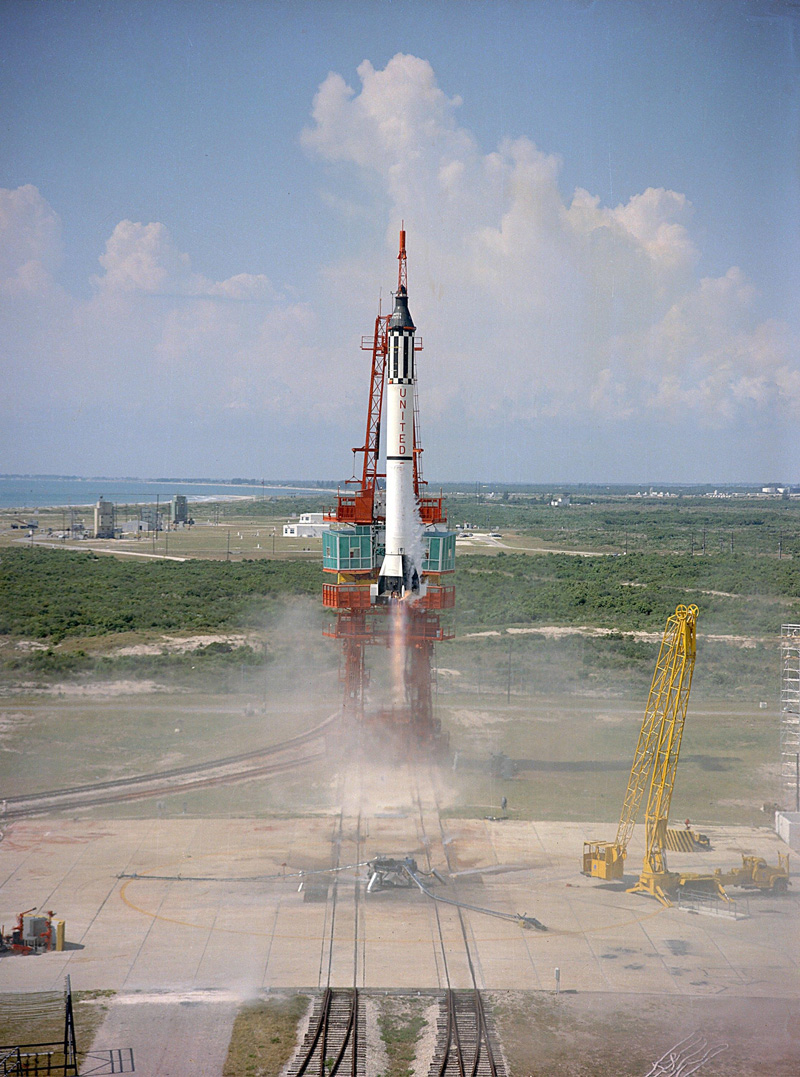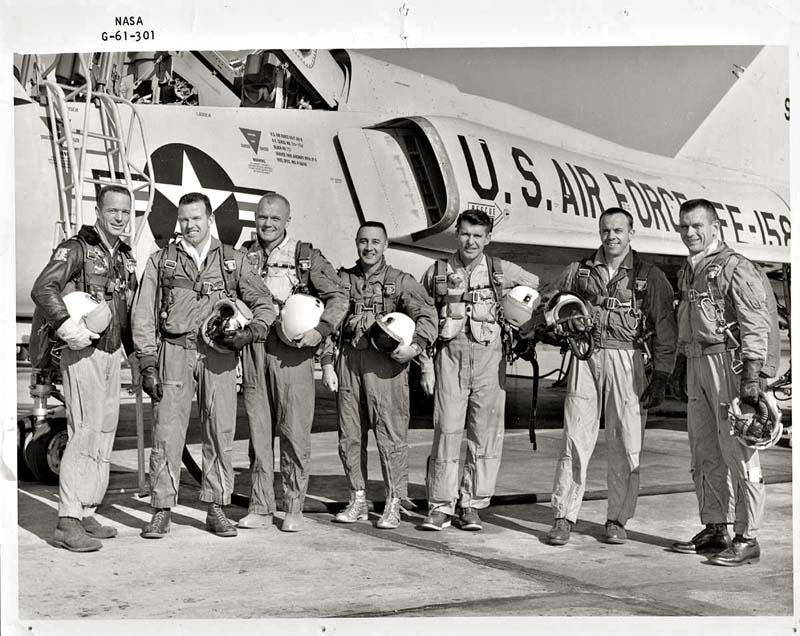Fifty years ago on May 5, 1961, only 23 days after Yuri Gagarin of the then-Soviet Union became the first person in space, NASA astronaut Alan Shepard launched at 9:34 a.m. EDT aboard his Freedom 7 capsule powered by a Redstone booster to become the first American in space. His historic flight lasted 15 minutes, 28 seconds. Photo and caption: NASA.
-
By Rod Sainty
Today is the 50th anniversary of America's first manned space flight, Freedom 7, on May 5, 1961. The photo below—today's Astronomy Picture of the Day—is an interesting counter-point to the Apollo 11 Saturn V photo Mike posted on July 16, 2009. There's a photo of Alan Shepard at NASA's Image of the Day Gallery.
I was very impressed with a short film on Alan Shepard's flight, with excellent historic photographs and footage interspersed with current-day interviews of an emotional Chris Kraft and Shepard's two adult daughters.
By the way, Jack King has a brief interview in the film; it's interesting to see the face behind the familiar voice that read the countdown for Apollo 11.
One of the world's most elite clubs: The original seven U.S. astronauts. From left to right, M. Scott Carpenter, L. Gordon Cooper Jr., John H. Glenn Jr., Virgil I. Grissom, Walter M. Schirra Jr., Alan B. Shepard Jr., and Donald K. Slayton. This print is for sale.
Rod
Send this post to a friend
Please help support TOP by patronizing our sponsors B&H Photo and Amazon
Note: Links in this post may be to our affiliates; sales through affiliate links may benefit this site. More...
Original contents copyright 2011 by Michael C. Johnston and/or the bylined author. All Rights Reserved.
Featured Comment by Paul W. Luscher: "I'm old enough to remember watching this. Remember they stuck on an old Laurel & Hardy movie for while, because of a technical delay. Much too young at the time (I was five) to realize the significance of this...."
Featured Comment by Richard Parkin: "As someone whose home was blown up by the predecessor of Werner von Braun's Redstone—launched with a different kind of payload when he was working for his previous employer—I have always had mixed feelings about this."
Featured Comment by Craig Lee: "I had the fortune to briefly meet Mr. Shepard at a local signing for his book Moon Shot. I remember him as a fairly humble man, who graciously spoke with everyone who had come to see him. Looks like I will have to read the book again this weekend.
"Oh, there are quite a few photographs from NASA's archives illustrating the book. There is also a film of the same name produced synchronously with the book."
Featured Comment by David Robinson: "All this sent me to Wiki for a good hour or so,loved this reply from Shepard when asked what he thought about while waiting to be launched atop the Redstone rocket: 'The fact that every part of this ship was built by the low bidder.' The only thing these guys get from me is awe."






The first American space flight was Explorer 1. Shephard's flight was the first American *manned* space flight. Not to detract from his achievement, of course.
Posted by: Will Duquette | Thursday, 05 May 2011 at 10:16 AM
Thanks Will. I made the clarification to the post.
Mike
Posted by: Mike Johnston | Thursday, 05 May 2011 at 10:19 AM
Let us not forget that "manned" space flight began with horrid cruelty:
http://en.wikipedia.org/wiki/Laika
Laika was sent to die in space. Her memory should live on.
Posted by: Scott L. | Thursday, 05 May 2011 at 10:27 AM
On space flight, the latest xkcd comic (http://xkcd.com/893/) is quite some food for thought (check out the alt-text).
Posted by: Martin Doonan | Thursday, 05 May 2011 at 10:37 AM
Cool. Another, related, elite club... http://jetpilotoverseas.wordpress.com/category/x-plane/
Posted by: MBS | Thursday, 05 May 2011 at 10:54 AM
The original photo of the "Mercury Seven" (copy at http://upload.wikimedia.org/wikipedia/en/e/e9/The_Mercury_Seven_in_front_of_a_F-106_Delta_Dart.jpg ) is in colour. Not being alive in 1959, was it routine back then to make BW copies of colour originals? I cannot immediately see any artistic reason to go for BW in this case - in fact the reverse, as manned spaceflight represented "the future" and colour was still relatively new to photography. Maybe it was more economical or just easier for the printers?
Posted by: James | Thursday, 05 May 2011 at 11:09 AM
I did not previously know this, but while looking at the Mercury Seven's photograph, I was delighted to discover that in the 1960s TV series Thunderbirds, the Tracy brothers were given the forenames of five of the Mercury astronauts: Scott, Virgil, Alan, Gordon and John.
Thank you Wikipedia!
Posted by: James | Thursday, 05 May 2011 at 11:12 AM
"was it routine back then to make BW copies of colour originals?"
James,
Most probably it was a PR print for newspaper repro. Few magazines and no newspapers ran much color back then, it was mostly B&W.
Mike
Posted by: Mike Johnston | Thursday, 05 May 2011 at 11:48 AM
I got to stay up all night before the Shepard flight and listen to the same information repeated over and over on radio and TV. My father was a career NCO in the Air Force so we got the 'inside scoop' from contacts on the base.
I can chart a direct path between the events of the early space program and my career as a software developer. Shortly after the flight my neighbor took me to the data center on base. He pointed out the connection between computers and space exploration and I was hooked forever.
Posted by: Ken White | Thursday, 05 May 2011 at 12:21 PM
If you look carefully at the faces you'll see that the BW and colour versions aren't the same shot. In fact, I suspect that the BW shot was taken first, as the astronauts look more relaxed and less bored than in the colour shot.
That, and the very nice tonality of the BW version vs. the colour, lead me to believe that the two shot were different films, probably in different cameras and maybe even by different photographers.
Posted by: BrianW | Thursday, 05 May 2011 at 12:56 PM
James -- No newspapers ran color that early, they didn't have the presses or other facilities for it.
There was even a special Kodak paper for making B&W prints from color negatives (Panalure). I used it for making prints of engagement portraits to be used in the newspaper engegement announcements when I was in highschool.
Posted by: David Dyer-Bennet | Thursday, 05 May 2011 at 01:27 PM
This is going to make me look like a total nerd... ;-)
You have to look seriously closely, but the B&W image here and the color image James linked are very very similar but not the same photograph.
Slight differences in facial expressions so they were taken within a moment of each other, and it looks like the color version was from a spot a couple of feet to the left of the B&W (compare head positions against the markings on the aircraft).
Posted by: Paul Glover | Thursday, 05 May 2011 at 01:47 PM
I've been enthralled by space travel ever since a kid: the engineering, science, and technology, the feat of space travel, and the hope that we may live somewhere, someday on another planet.
A friend of mine who's a physicist also pointed out the courage of these men, in a rather humourous layman's description of their task.
"Job description: experience pilot wanted to sit on top of a giant firecracker whilst ground crew light it. Controlled explosion expected, but might go bang."
Hearing that over a beer and 20 years or so after giving up the dream of becoming an astronaut, really put those guys into another league for me.
Pak
Posted by: Pak-Ming Wan | Thursday, 05 May 2011 at 01:49 PM
The thing that struck me about that fifty year-old photo of the MR-3 launch was just how "sparsely appointed" the launch area was compared to the STS launch pads of today:
http://www.launchphotography.com/STS-133_pad_sunrise.html
Cheers! Jay
Posted by: Jay Frew | Thursday, 05 May 2011 at 02:00 PM
See too: http://www.life.com/hdgallery/59671#index/0
Alastair
Posted by: Alastair Smith | Thursday, 05 May 2011 at 02:35 PM
If anyone wants to see 900 more photos, my Space Flight Photos app is now in the App Store, for the iPad/iPhone/iPod. All from a NASA web site, with extensive captions (over 100,000 words).
Details at http://basepath.com.
--Marc
Posted by: Marc Rochkind | Thursday, 05 May 2011 at 02:46 PM
'only 23 days after Yuri Gagarin'? Gagarin orbited the Earth. Sheppard was shot up in the air and landed just 190 miles from the launchpad.
Posted by: Yger | Thursday, 05 May 2011 at 06:00 PM
Featured comment by Craig Lee. Is that the Craig Lee that does great work for the San Francisco Chronicle?
A few years ago, every week the food and wine section would have a great location shot by Craig Lee. Now I guess they don't send him out on location so much.
-Tom-
Posted by: Tom V | Thursday, 05 May 2011 at 08:56 PM
Dear Marc,
Do all the images come up full-screen, full-res in the iPad (subject to format constraints, of course)?
If so, you just sold one to me.
pax / Ctein
Posted by: ctein | Friday, 06 May 2011 at 12:17 AM
Oh yes I remember the Kodak Panalure papers. Being broadband color sensitive they called for very dim greenish darkroom lighting
Posted by: Tom Fangel | Friday, 06 May 2011 at 05:21 AM
The original Seven (and the cosmonauts) were the real deal. I was a young engineer working on satellites in the late 1980s. On a trip to DC, I made a visit to the Air and Space Museum and when I looked at the Apollo II capsule I thought "what a piece of junk!". The Apollo II capsule was generations better than the Mercury capsule, too.
Truly brave and dedicated men.
Posted by: Jim | Friday, 06 May 2011 at 09:50 AM
The USSR was ahead of the U.S. in heavy lift rockets in those early days. Gagarin did indeed orbit the earth, and Shepherd's flight was suborbital. But Shepherd actually did some piloting of his spacecraft, whereas Gagarin's was controlled entirely from the ground. None of this detracts from either man's achievement. Though the dogs and chimps previously launched gave some indication that it would be OK, nobody knew for sure how the human body and mind would react to space flight until they actually tried it.
Posted by: Peter Klein | Friday, 06 May 2011 at 02:12 PM
I was in fifth grade when the first Mercury flights happened.
I remember waiting for the last possible instant to go out to the bus stop, so I could watch the launch on tv. Finally had to go out before we got word on the landing, and the bus was late. Long enough that as it was pulling up, my grandmother shouted from the front door that he'd splashed down and had been picked up safely.
It was a big deal back then...and I've been space- and aviation-mad ever since.
Posted by: steveH | Friday, 06 May 2011 at 02:41 PM
@Ctein--
Yes. The images shown on the iPad are iPad-sized, and they fill the screen. That is, a horizontal is 1024x768, and a vertical is 768x1024.
From what I can tell, NASA scanned the original negatives at pretty high resolutions. In many cases those negatives were medium format.
Images are hosted on SmugMug, and the originals are there, so prints can be large.
--Marc
Posted by: Marc Rochkind | Friday, 06 May 2011 at 03:17 PM
' ... only 23 days after Yuri Gagarin of the then-Soviet Union became the first person in space, NASA astronaut Alan Shepard launched at 9:34 a.m.'
Possibly the least convincing gloss ever put on second place.
Posted by: Jim McDermott | Saturday, 07 May 2011 at 12:52 AM
Yes, May 5th is my birthday and I was there!
Knew and worked with all 7 and some of the Gemini astronauts. It was a great day! But John Glenns orbital flight a year later was even more impressive.
It is true that the newspapers at that very time were not printing in color, however only a few years later during the Apollo program the today paper (florida today not USA Today) was printing in color.
Posted by: Robert Kimmel | Saturday, 07 May 2011 at 11:41 PM
I was in 6th grade on that day 50 years ago, and I remember that the last minutes before the launch and the launch itself was piped over the PA system. What an exciting day for me, an 11-years old who was nuts for anything related to space travel, missiles, and especially the Mercury astronauts.
That summer, I remember getting up early three days in a row to watch the 2nd Mercury-Redstone launch (Gus Grisson, Liberty Bell 7.) The first two days, the launch was postponed each time for one reason or another. Finally, on the third day we got to see Gus lift off, and later, almost drowned during the recovery (I wasn't aware at the time what a close call it was for Gus.)
Posted by: Steve Rosenbach | Monday, 09 May 2011 at 05:55 PM